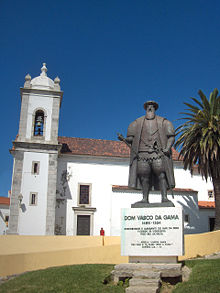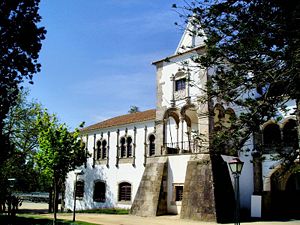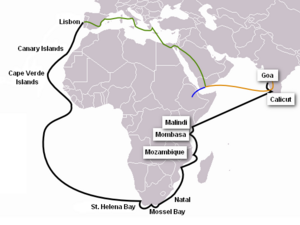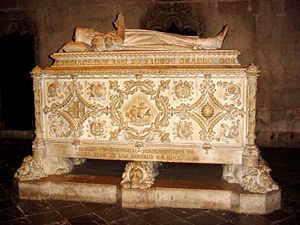Vasco da Gama
Vasco da Gama (c. 1469 – 24 December 1524) was a Portuguese navigator during the European Age of Exploration. He is notable for having established a sea route from Europe around the southern tip of Africa to India.
Early life
Few details are known about Vasco da Gama's early life. He was born around 1469 in Sines, a seaport in the southwest coast of Portugal, or in one of the nearby villages (the most likely candidate is Salas, where after his return from his first voyage to India he ordered the construction of a church). He was the second or third child of Estêvão da Gama and Isabel de Sodré. Vasco was named after his paternal grandfather, who served as alcaide (magistrate) of Évora.
Vasco’s father was a member of the Order of Saint James of the Sword and had a close ties with its master, D. Fernando, Duke of Viseu (a brother of the Portuguese king Afonso V). He participated in the military campaign against the Moroccan town of Casablanca (1468-69) and served as alcaide-mor (chief magistrate) of Sines and Silves. Vasco’s mother was of English ancestry, the granddaughter of a nobleman named Sudley, who had fought against Castile and settled in Portugal.
One of the few documents concerning the early life of Vasco da Gama shows that he was apparently destined to become a cleric, as on 5 November 1480 he had the prima tonsura, alongside his brothers and his uncle Vincente Sodré.
In 1492 Vasco received from King John II of Portugal the mission to seize all French ships on the ports of Setúbal and in the ports of the coast of the Algarve, in retaliaton for attacks performed by French pirates on Portuguese ships carrying slaves. According to the poet Garcia de Resende, on his work Crónica de D. João II (Chronicle of John II), Vasco da Gama bravely and successfully performed the task.
First voyage
The reign of John II was marked by his desire to find a sea route from Europe to India that would break the Muslim monopoly on trade with India. The king also wanted to establish contacts with Prester John, a fabled Christian ruler thought to live in Ethiopia, who was expected to ally with Christians in the fight against Islam. To achieve these goals, John II sent two explorers in May 1487, Pero da Covilhã and Afonso de Paiva, on an overland voyage to the Middle East and India. Both men (who were fluent in Arabic), traveled together as far as Aden, when Covilhã went to India and Afonso de Paiva to Ethiopia, the latter carrying with him letters that offered an alliance to Prester John.
Another important voyage was that of Bartolomeu Dias, who in his 1487-88 expedition, rounded the Cape of Good Hope and sailed as far as the Great Fish River. As a result of the voyage, it was almost certain that the Atlantic and Indian oceans were not landlocked and that India could be reached by sea. Vasco’s father was chosen by King John II to lead the follow-up expedition that was to establish a sea route to India, but both Estêvão and the King died before the project could be realised. Portugal’s new king, Manuel I, put into practice the plans of his predecessor and appointed Vasco da Gama captain-major of the expedition.
Vasco da Gama’s fleet was composed of four ships: the St. Gabriel, under his command; the St. Raphael, under the command of his brother, Paulo da Gama; the Bérrio, whose captain was Nicolau Coelho; and a supply vessel commanded by Gonçalo Nunes that was to be burned after its provisions were distributed by the others' ships.
The crew is estimated to have been between 150 and 170 men, some of them convicts who were to perform dangerous tasks. Joining the fleet was a caravel captained by Bartolomeu Dias that followed as far as the Cape Verde islands, whence it travelled to the Portuguese trading post of Elmina in West Africa. Modern knowledge of the expedition course is based on a voyage log written by Álvaro Velho, a member of the St. Raphael (although some scholars attribute it to João de Sá).
The fleet departed from Lisbon July 8 1497. After passing by the Canary Islands, the ships arrived at the island of Santiago in the archipelago of Cape Verde. The journey resumed on 3 August, with the ships sailing south and then southwest, far from the African coastline, describing a big arc, in order to avoid unfavorable winds. The fleet stayed on open sea for 96 days, longer than Christopher Columbus had on his first voyage to the Americas. On 8 November they anchored on the south coast of Africa, in a bay named Saint Helen, where Vasco da Gama measured the height of the sun with his astrolabe and realized that they were near the Cape of Good Hope.
On 22 November the fleet rounded the Cape of Good Hope and three days later anchored at Mossel Bay, where it remained for 13 days. At Mossel Bay the Portuguese made contact with the native Khoikhoi people and burned the supply vessel. They also erected a stone pillar (padrão), an act that proclaimed Portugal’s sovereignty over the place. They saw it being destroyed by the locals as they left.
By 15 December the fleet had passed the furthest point reached by Bartolomeu Dias ten years before and were sailing northwards along the east coast of Africa. On Christmas Day Vasco da Gama named a part of the coast Natal, from the Portuguese word for Christmas. After a stay on the mouth of Copper River (named after the copper ornaments used by the people of the region), the expedition anchored on the Quelimane River on 25 January and stayed there for 30 days. The long stay was necessary because of the poor health of many members of the expedition and also because of necessary repairs to the ships. It was here that they learned about the presence of Arab merchants in the region.
Vasco da Gama’s expedition reached the Island of Mozambique on 2 March, which was at that time the southernmost point of Muslim influence in eastern Africa. Initially the Portuguese were well treated, as they were thought to be Turkish merchants. When it was realized that they were Christians, the Portuguese were forced out by the local population. At Mombasa, on the coast of present-day Kenya, they found similar hostility.
At Malindi, Vasco da Gama had a welcoming reception from the sultan, who provided him with one of the best pilots of the time, an Arab, Ahmed ibn Majid. With his help the crossing of the Arabian Sea was made in 27 days, taking advantage of the monsoon winds. The fleet arrived at Calicut (present-day Kozhikode in the state of Kerala) on 20 May 1498.
The Portuguese spent three months in India. Acting as a representative of King Manuel, Vasco da Gama tried to establish political and commercial ties with the Hindu local ruler, the Zamorin. At first, the Portuguese were well treated, but because of the influence of Muslim merchants at the local court, who spread rumours that the Portuguese were pirates (as they feared Portuguese commercial competition), relations deteriorated. Moreover, the cheap goods that the expedition brought from Portugal were not suitable for doing business and were even ridiculed by the Zamorin.
Vasco da Gama's fleet left Calicut on 29 August 1498. Sailing north, they passed by Angediva Island, near Goa, on 5 October. Having lost their pilot and facing unfavorable monsoon winds, it took almost 3 months to reach Malindi. About 30 men died from scurvy. At Malindi Vasco da Gama ordered the destruction of the St Raphael, since its captain Paulo da Gama was sick from tuberculosis, and also because the size of the crew had diminished.
The fleet rounded the Cape of Good Hope on 20 March 1499 and then proceeded to sail along the African coastline, having as their destination the Cape Verde Islands. From there the Bérrio sailed alone to Lisbon, where it arrived on 10 July 1499. On the island of Santiago Vasco da Gama handed the St. Gabriel to João de Sá, who was to repair it and then take it to Lisbon, while he and his sick brother embarked on a caravel to seek medical treatment. Realizing that it would be impossible to reach Lisbon in time, the ship sailed to the Azores, where Paulo da Gama died, in the city of Angra, on Terceira island.
For unknown reasons Vasco da Gama spent the next two months on the Azores (probably mourning the death of his brother or recovering from an illness), only arriving at Lisbon on 29 August 1499. Back at the capital, Vasco got a triumphal reception from King Manuel and the people of Lisbon. The monarch awarded him with the lordship of Sines and the title of Dom (Lord). He was also nominated to the newly created post of Admiral of the Indian Ocean and was promised the title of Count. In 1500 or 1501 Vasco da Gama married Catarina de Ataíde, who bore him six sons and one daughter: Francisco da Gama, Estêvão da Gama (who served the Portuguese crown as viceroy of India), Pedro da Silva, Paulo da Gama, Cristóvão da Gama (leader of an expedition to the Prester John), Álvaro de Ataíde and Isabel de Ataíde.
Second voyage
After Vasco da Gama's voyage, King Manuel I dispatched a new expedition to India under the command of Pedro Álvares Cabral (1500-01). It resulted in the establishment of a Portuguese trading post in Cochin.
On 12 February 1502 Vasco da Gama commanded a new expedition to India whose mission was to secure Portuguese interests and to avenge the death of Portuguese men left by Cabral. After passing by the Cape Verde Islands, the ships anchorend on Goree Island on 28 February, where Mass was celebrated. Once again Vasco took the fleet on a long loop into the Atlantic Ocean that began on 6 March, staying 87 days on open-sea. At the African east coast the fleet passed by Sofala and Mozambique, and then arrived at Kilwa, in the modern nation of Tanzania.
At Kilwa, Vasco da Gama threathened with violence its local ruler, Amir Ibrahim, if he did not agree to become a vassal of the King of Portugal and pay tribute. Ibrahim, who had been hostile to Cabral and his men, accepted Vasco's ultimatum. As the expedition was leaving Kilwa, it met a squadron of five ships commanded by Estêvão da Gama (a nephew of Vasco) that had left Lisbon 1 April. From thence the ships sailed to India, reaching Cannanore in the beginning of September.
At the end of this month, Vasco learned about the arrival of the Meri, an Arab ship carrying between 200 and 400 passengers, mostly Muslim pilgrims returning from Mecca and decided to attack it. Although some passengers tried to offer their riches to da Gama in exchange for their lives, he refused and set the ship on fire with the passengers aboard.
After forming an alliance with the ruler of Cannanore, Vasco sent a message to the Zamorin, announcing his arrival and his desire to establish a commercial treaty. The Zamorin agreed to the request, but later changed his mind when Vasco captured four ships. In retaliation, Vasco bombarded Calecut and then headed south to the port of Cochin. The city's ruler, Goda Varma, agreed to met Vasco on his ship, where a trade treaty was established. Contacts were also made with Christians from India, who offered pepper to the Portuguese.
While the Portuguese were still in Cochin, the Zamorin tried to plot against Vasco, sending him a brahmin with the message that he was now agreeing to his requests and wanted to meet him in person in Calecut. On the night of 3 January 1503, when Vasco was heading for the meeting, his ship, the Flor de la Mar, was attacked by the ships from the Zamorin; on the ensuing battle the Portuguese managed to win.
The voyage back to Portugal began on 20 February 1503. On this occasion, Vasco once again took a daring decision: he ordered the ships to take a direct course from Cannanore to Mozambique (instead of making a stop at Malindi as they had done on the previous voyage), where they arrived on 12 April.
Third voyage and appointment as Viceroy of India
Returning to Portugal from his second voyage in September 1503, Vasco da Gama spent the next twenty years without being commissioned to make another overseas expedition. He served as advisor on Indian affairs to King Manuel until 1505. However, the lordship of Sines, promised to Vasco da Gama after his first voyage, was the source of some tension, as the owner of the town, the Order of St. James of the Sword, refused to concede it to him. The situation reached a point where Vasco da Gama and his family were forbidden from entering Sines by a royal edict issued on March 1507. During the following years, Vasco lived on Évora, Nisa and Lisbon. On December 1519 Vasco da Gama was created Count of Vidigueira, the town he received instead of Sines.
On 9 April 1524, after being appointed viceroy to India by King John III, Vasco da Gama sailed to India, accompanied by his sons Estêvão and Paulo. He arrived at Goa in September of the same year and began correcting abuses committed by his predecessors. He extended his work to Cochin, where he died at the house of a Portuguese merchant on the night of 24 December 1524. He was buried on St. Francis Church in Cochin, dressed in a cloak from the Order of Christ.
In 1538 his remains were brought to Portugal by order of his son Pedro and interred in the chapel of Nossa Senhora das Relíquias in Vidigueira, a building that fell apart at the end of the century. In its place a grandson of Vasco, Miguel, ordered the construction of a new church, where the remains of da Gama were placed and rested in peace until the 19th century. In 1834 a decree of the Minister of Justice, Joaquim António de Aguiar, ordered the destruction of convents in Portugal; as a result, the monks left the building and the chapel and the tombs suffered vandalism during the following years. Some years later, in 1880, the remains believed to belong to Vasco (identified as those from a tomb placed on the right side of the altar of the chapel) were placed on a marble sarcophagus in the Monastery of the Jerónimos in Lisbon. However, four years later the historian Teixeira de Aragão discovered a 1646 document from the convent that stated that Vasco da Gama had been buried on a tomb on the left side of the chapel's altar. In 1898 the correct remains were place on the Jerónimos' sarcophagus.
Bibliography
- Boorstin, Daniel J. The Discoverers (1983)
- Disney, Anthony, and Emily Booth, eds. Vasco da Gama and the Linking of Europe and Asia (2000), 504pp articles by scholars
- Panikkar, K. M. Asia and Western Dominance: A Survey of the Vasco Da Gama Epoch of Asian History, 1498-1945 (1953) online edition
- Northrup, David. "Vasco Da Gama and Africa: an Era of Mutual Discovery, 1497-1800." Journal of World History 1998 9(2): 189-211. Issn: 1045-6007 Fulltext: Project Muse
- Russell-Wood, A. J. R. A World on the Move: The Portuguese in Africa, Asia, and America, 1415-1808 (1993)
- Sanjay Subrahmanyam, The Career and Legend of Vasco da Gama. Cambridge University Press, 1997, the standard scholarly biography
- Wolff, Robert S. "Da Gama's Blundering: Trade Encounters in Africa and Asia During the European 'Age of Discovery,' 1450-1520." History Teacher 1998 31(3): 297-318. Issn: 0018-2745 Fulltext: in Jstor
Primary sources
- Ravenstein, E. G. ed. and trans. A Journal of the First Voyage of Vasco da Gama: 1497-1499 (1898) full text online



